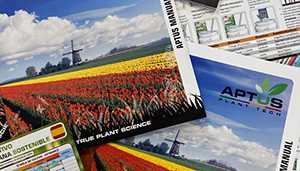FAQ
- Home
- FAQ
FAQ
Technically, pure minerals are not organic because they don’t contain a carbon atom (which is a scientific requirement for being organic). However, minerals mined from the earth and processed using specific natural methods may be approved and accepted for organic farming. When processed this way and chelated in organic L-amino acids, we call this organo-mineral. The combination of organic and natural mineral components.
Many products labeled “bloom boosters” are really just phosphorus and potassium supplements. While both minerals are important to good floral development, Topbooster focuses on plant and microbial bio-stimulation. If you need P and K supplementation, use P-Boost and K-Boost.
Once silicon is deposited in the cell membrane, it stays there for the life of the plant. So it’s important to keep a continuous supply to strengthen all the newly formed cells.
You can but you risk a lot of mess. StartBoost contains spore-form bacteria. When mixed in water they come alive and go to work. One thing bacteria do well is produce a biofilm, or slime, as a way of stabilising the soil and providing protection. This is good in the soil but not so good in a recirculating nutrient tank. Plus, environmental factors such as water temperature, aeration, nutrients, and possible contaminants may start to degrade or affect your mix.
Every situation is a bit different. Most growers using coco have good results at the recommended dosage. And depending on your base fertiliser, you may want to supplement with CaMg earlier in the vegetative phase.
True P-Boost numbers are lower than many products on the market. When the minerals are organically chelated, they are 100% bioavailable and resistant to antagonism and lockout. This means you ultimately need far less input, which saves money and the environment.
No. You can use Startbooster at multiple times the recommended dosage. Startbooster is 100% organic and contains nothing that will burn or harm your plant. Dump a full bottle and a plant and the worst that may happen is a temporary imbalance in your soil (excess organic acids may over chelate and not release minerals as readily to the plant).
Sulfur is a secondary element needed for almost all biological processes within a plant. In healthy soils, sulfur is usually available in high amounts and is not needed as supplementation. You may see only minimal or moderate levels in other boosters. As with other minerals, we want to ensure that sulfur is bioavailable and ready for immediate uptake when the plant needs it.
Those enzymes that breakdown salts are even faster acting in a solution than in soil. If you leave Enzym+ with nutrients for too long, there are complex chemical interactions that can degrade your nutrient solution and affect availability of the nutrients.
You usually won’t need any additional NPK fertilizer since All-in-One Pellets provide sufficient base nutrition. That’s the great thing about All-in-One Pellets, its effectiveness completely on its own. Adding the Aptus boosters will help to further increase bulk and yield, to help you boost the plant to maximize its genetic potential
Most other nutrients contain ballast salts and chlorides apart from usable nutrients. These all register as EC too, even though they’re not the nutrients your plant needs. All-in-One Liquid doesn’t contain any of these chlorides or ballast salts, and therefore we advise to keep your EC 20-30% lower than you normally do.
Growers in Europe report that subsequent cycles with the same growing medium are more productive than the first. When Aptus has a chance to create a thriving and balanced ecosystem in the medium, it’s a shame to throw it away after only one use!
Towards the end of your cycle, you’ll want to introduce more carbon (usually from Humic and amino acids) to the medium. This will help enhance structure to hold on to micro-life. Also, use ENZYM+ to help break down any dead organic material (cellulose) and residual mineral salts. You can do it with soil, soilless mixes, perlite, and clay pellets. It’s a good idea to lay the medium out, break up clumps, remove large root balls, and let it mostly dry out.
There is some risk. If you have issues with soil pests like aphids and fungus gnats, or pathogens, nematodes, etc. never re-use your medium! But if you have a healthy, clean, balanced growing environment and medium, re-using you medium is a great way to cut costs and work. We’ve found that the use of the Aptus ALL-IN-ONE PELLETS can help a lot to maintain a good micro-life and nutrition balance in soil and coco. The pellets don’t contain nutrient salts, but only organic NPK compounds combined with lots of L-amino acids. It is the best way to grow in an organic way and re-use your medium.
You can find L-amino acids in A LOT of our products: Startbooster, Topbooster, Super-PK, N-Boost, P-Boost, K-Boost, CaMg-Boost, Fulvic-Blast, Humic-Blast, Micromix Soil, All-in-One Pellet.
We love using them because they are excellent chelators. Simply put, that means L-amino acids make other (harder to take up) nutrients plant-available. L-amino acids are a great source of organic nitrogen too, which provides more controlled growth (less stretch) and stronger cell walls. Apart from that L-amino acids are used in lots of processes in plants. Even though plants can synthesize all amino acids themselves, providing them leaves plants with more energy to focus on higher-level functions like producing oils, resins, terpenes, etc.
This is not needed as Aptus already provides high concentrations of specific micro-life in the feeding schedule. When soil or coco-peat is used as a growing medium, initial inoculating of microbes is in most cases efficient enough. As rockwool is notoriously bad at holding on to beneficial microbes, re-inoculating is a good idea. STARTBOOSTER and MICROMIX contain high populations of specific beneficial bacteria and TOPBOOSTER (as well as other products) feeds those microbes throughout the bloom cycle so you don’t need extra supplements.
These so-called “bloom boosters” are nearly always highly processed chemical salts that are not in a form how nature prefers minerals. The high quantities of P and K are nearly certain to create imbalance and antagonism with other important bloom nutrients like Calcium and Iron.
Modern agriculture has taught us that we need high levels of certain nutrients to boost the plant growth. This has resulted in sick crops, depleted soil, pest and disease vulnerability, low nutritional content, and lack of flavor. Nature teaches us that balanced levels and bioavailability of nutrients is what truly helps the plant maximize genetic potential.
P-Boost (P) and K-Boost (K and S) contain ideal levels of bloom enhancing minerals that are chelated in L-amino acids to make them immediately bioavailable to plants. We have split P and K into two products since plants require different levels of these minerals at different stages. This allows more targeted feeding for different plants.
Many growers like to add lots of “sweeteners” to their mix because it is reputed to increase sugar production and flavor profiles in the plant. This is not really true. Plants rarely absorb sugars from outside sources. Plants produce their own sugars via photosynthesis. These sugars are used for energy and other processes within the plant tissue. Remaining sugars are secreted through the roots to feed microbes…this is the primary benefit of adding additional sugars to your feed mix. If a plant is healthy and properly mineralized, more sugars are not needed.
Adding sugars is only beneficial to the micro-life. Improved micro-life enhances mineralization and thus higher brix and better flavor. So it is an indirect effect and not what many sugar-based products claim: that it improves taste and flavor directly, as sweeteners are not assimilated by plants.. Also, some sweetener products contain hormones, PGRs and other unlisted synthetic stimulants that can create more imbalances in plant health.
TOPBOOSTER and ENZYM+ contain high-quality polysaccharides, which are ideal food for your beneficial microbes so additional sugars are not needed.
All Aptus nutrients are extremely concentrated. We don’t add any water to dilute the active ingredients. Instead we use plant available L-amino acids. This means every drop is active material the plant uses to build itself. It also means that you only pay for beneficial ingredients rather than very expensive water.
As the products are super concentrated the purchase price per bottle seems high, but due to the dilution rate it becomes one of the cheapest products to use on the market.
Some of our ingredients are pharmaceutical or food grade and manufactured under Good Manufacturing Processes (GMP) to assure purity and consistency. We always choose the most pure sources of ingredients (minimal contaminants), which contain properly structured minerals for the best compatibility with plants.
For example, our source of L-amino acids is natural and organic. They are produced through controlled enzymatic hydrolyzation, which is a complex process where we mimic natural processes that create a complete profile of all essential amino acids. More importantly, the amino acids produced are left-turning, which is the only form that is recognized and used by nature. The assimilation of L-amino acids does not consume any energy for the plant and the L-amino acids are quicky absorbed and translocated throughout the plantsap
The manufacturing methods of these L-amino acids are complicated and expensive, but they are the best and most reliable and allow us to obtain the highest concentrations in the market.
Aptus boosters contain active ingredients and no added water. This means you need smaller doses than other products. Also, all the minerals in Aptus products are naturally chelated and fully bioavailable. This way, plants are able to take up and utilize more of the nutrient material you add, so you need far less to feed your plants the same.
This is a difficult question to answer because there are many factors at play: growing medium, plant strain, light levels, growing method, temperatures, water usage/source, etc.
Generally, you will need much lower PPM/EC levels than you usually use. Most Aptus boosters have minimal effect on PPM/EC levels due to the organic ingredients. Many Aptus growers report PPM/EC levels 20-40% less than with previous recipes.
Most of your EC will come from your base NPK fertilizer. We recommend following the usage instructions on the bottle or feed schedule from the base NPK manufacturer. And when starting young plants for the first time, cut the base NPK recommendations in half and see how the plant responds.
Remember that balance is more important than quantity. High EC is usually necessary if the nutrients are not bioavailable. When nutrients are properly and naturally chelated, plants better utilize and thus, need less. Also if you have salt build up, you probably are feeding too much. (read our blog ‘WHAT EC SHOULD I USE’ to learn more.)
Aptus is not for everyone. If you truly have no issues in your garden and consistently get incredible yields using minimal cost fertilizers, perhaps you should stay the course.
But in our experience, every grower has some sort of issue they deal with regularly— perhaps pests, mildew, pathogens, deficiencies, or simply the cost of their nutrients.
Every grower has different goals, skills, and challenges. If expensive nutrients are lowering your profitability, Aptus can likely save you money due to product concentrations. If you experience occasional deficiencies or plant health issues, the balanced nutrition of Aptus Boosters will maintain plant health throughout the cycle. If you face regular pest and disease attacks, Aptus helps increase internal Brix and pH levels, which naturally aid in pest and disease resistance.
Most important, is testing. Every great grower knows they don’t know everything. Aptus is new nutrition technology to most people. Belief comes from experience. If you are good enough to consistently get amazing results, there’s still a good chance Aptus will help you improve something, whether yield, quality, or cost. Try it; test it; tell us what you see.
Aptus plant nutrition began in the large-scale commercial agriculture market where results and investment matter. Crop farmers have a lot to lose if something doesn’t work. Changing methods is also a very costly endeavor because of equipment, time, and investment. Most farmers will only change their methods when they see drastic difference in results.
We looked at natural soil and plant processes and replicated the form and quantities of minerals. APTUS collaborates with top universities and researchers, and thousands of plant tissue and soil samples have been analyzed in order to find the proper balance of nutrients that maximizes the uptake, internal transport, and usage of those minerals.
Proper nutrition is not just having the necessary minerals mixed together. Most important to healthy, vital, and productive plants is the balance and bioavailability of nutrients. With Aptus you are able to use far less fertilizers because all the minerals are chelated in L-amino acids rather than synthetic chelates the plant can’t recognize.
Several of the technologies used in Aptus nutrients are unique and patented. We didn’t invent the technologies; nature invented them millions of years ago. Our research simply identified the natural processes and how to practically apply them more quickly.
It’s always important to ensure your feed water’s pH is at the proper level for your growing medium. Some of the boosters will raise and lower your pH slightly due to the organic compounds and other ingredients. P-Boost contains organic acids and can be used as a pH down solution that also adds bioavailable phosphorus and L-amino acids. Super-PK has an opposite effect, and can be used as pH up solution. Regulator has a down effect, but mainly in RO water. CaMg-Boost and K-Boost have a slight pH up effect. If your pH lies outside of the desired range after completely mixing your feed water, it’s best to use a mild pH up or down like since harsh acids and bases can affect micro-life in the mix.
Flushing is an interesting practice. It’s intended to get rid of the built up salts which can negatively affect flavor and quality. More important to ask is, why are their built up salts? Perhaps the issue is over fertilization with chemical salt based fertilizers. If there is proper balance of nutrients in bioavailable form, you shouldn’t need to feed so much. Thus, lowering the need for any kind of flush. Also, flushing washes out good stuff with the bad. You’ve spent a lot of time and money adding nutrients and micro-life to your soil, so why just flush it out? It is certainly okay to feed with just water occasionally to give the soil and plant a rest. But flushing is usually a wasteful practice and less necessary when using Aptus. Some Aptus growers stop feeding with their base fertilizer 1-2 weeks prior to harvest but continue with the Aptus boosters through the end. Because there are none or a strict minimum of salts in Aptus products, this seems to enhance yield and quality without affecting flavor.
Use Regulator! The mono-silicic acid in Regulator gives your plants the protection they need to deal with extreme weather conditions, like heat. The standard dosage is enough to keep your plants going, even when temperatures creep up to uncomfortable levels.
Helping your plants deal with the heat is the first step. The second step is trying to find ways to get your temperatures stable at normal levels again. You may want to increase air exchange to get rid of hot air quicker, increase humidity, maybe even dim or turn off a light or two. It all depends on your situation. Don’t be afraid to reach out if you’re struggling with this issue. We might have a tip or two for you!




